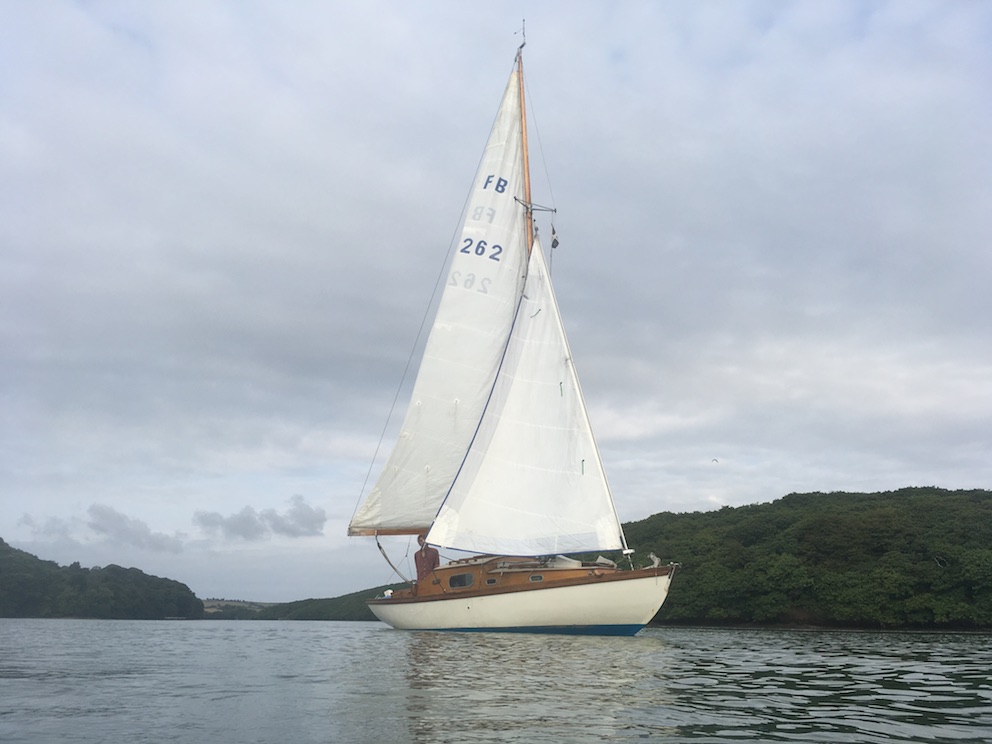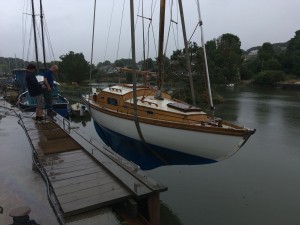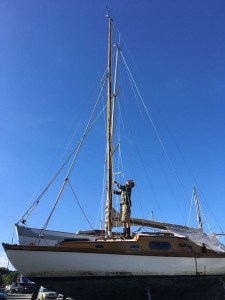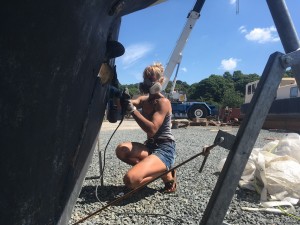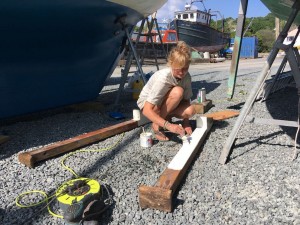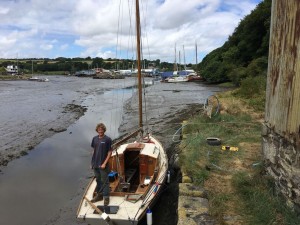Jasper Troje Tuck, crew on the commercial sailing lugger Grayhound, writes for CS about taking ownership of a 1960s wooden Folkboat, and getting her ready for a first sail… plus giving her some “legs”
Vie is an East German Folkboat, built in 1963. The hull construction is carvel strip planked mahogany on oak, fastened with bronze screws. Unlike the Nordic Folkboat she has a raised coachroof, which makes a very big difference to living space down below. She also has a small inboard diesel engine, an Arona AD182, which is apparently a marinised Lombardini engine. I haven’t had this working yet, but that’s not a priority for me, she’s a sailing boat after all.
She came into my ownership about 5 weeks ago, under fairly unusual circumstances. I’ve been professional crew on the Grayhound, a 3 masted lugger, for the last two seasons. The whole time keeping half an eye out for a decent project for myself, with the idea to find a boat to live on and do some cruising with. I got a phone call one afternoon from a friend asking if I knew anybody who would be willing to take on an old Folkboat in Gweek (Cornwall) that was in need of a new owner. We were in Brittany at the time, working our way down the coast from Douarnenez to Nantes, so I wasn’t able to go and see her myself. Luckily my dad, a sailor and boatbuilder, was able to go and survey her for me. He deemed her to be a suitable first project for me, so we signed a bill of sale for £1 the following day and all of a sudden I was a boat owner.
I went to see her myself for the first time during on an evening off work at Falmouth Classics, and was pleasantly surprised to find her in a very good condition! She was starting to open up at the seams quite a lot though, due to the unusually hot and dry weather we’ve had this summer. Apart from this though she’s very much sound. There are some broken frames in the bilge which I intend to replace, and the mast and rigging certainly need a good looking at, but for a £1 boat I couldn’t ask for more. Four years ago she had a very big refit done by the shipwrights in Gweek Quay Boatyard, including a new deck and new keel bolts, amongst many other jobs, so the majority of the work to be done is cosmetic really. The following weeks of work onboard the Grayhound were spent formulating a plan for her during my two week period of leave we had coming up.
I decided that I had to launch her as soon as possible, and to prioritise the jobs that were absolutely necessary to getting her afloat and moving again. I organised a berth for her on a drying mooring up a muddy creek near Falmouth, amongst a lovely community of other wooden boat owners, and started to make plans to move her there from Gweek. Our craning date was scheduled for three days after we arrived in Cornwall on our leave, so we had quite a tight schedule and had to work quickly. We arrived in Falmouth late on a Thursday night, with the cranage booked for Monday morning.
My priorities were to build a pair of legs so that she sat comfortably on her new mooring, fill up the seams that had opened up below the waterline, get a few good coats of antifouling on the hull, and get the engine to start so that we could motor over to her new berth. We spent a very busy first day grinding paint off the dodgy seams and filling them up with a mixture of red lead putty and grease, in the hopes that it would seal them up temporarily until the planks swelled up and pushed the putty out again. Georgie spent the next couple of days putting several coats of antifouling on her, while I put together a pair of legs and began to look at the engine. The legs were a good challenge that I enjoyed getting my head around, and after chatting to somebody in the yard I ended up repurposing a pair off another boat to fit Vie, which worked very nicely. The engine was another story though, mechanics is something that doesn’t come naturally to me and I have very little experience with marine diesels. By Monday morning we still hadn’t got it running, so we launched anyway and towed her around to a quayside nearby. She didn’t leak nearly as much as I had thought she might, especially seeing as we had been able to see daylight through the seams just a few days before.
We spent our first night onboard that night, after lashing up a massive double bed that spanned most of the cabin. It felt amazing to be floating for the first time on her, settling her into the mud on the quayside up the quiet river. A friend had offered to come and get the engine started the next day, but due to unforeseen circumstances he wasn’t able to, and we were keen to get moving. We spent a relaxed morning bending on the sails, which are in a pretty poor condition, but useable, and planning the sail down to Falmouth. After borrowing a pair of paddles from a friend’s canoe, just in case, we set sail from our quayside spot on the evening tide.
The first sail that evening was amazing, beautiful golden sunshine and a nice light wind funnelling down the river pushing us slowly on our way to Falmouth. As the sun went down the wind died off, so we dropped the anchor halfway down the river just after dark. The next morning we woke up early with the sun, and found a mirror calm river with no wind to speak of and the tide against us. While waiting for either the wind to pick up or the tide to turn, Georgie went swimming and took some excellent photos of the boat. As she was swimming the wind picked up a little, so she climbed back onboard as I weighed anchor and we set off under sail. The wind didn’t last long and we found ourselves paddling towards the moorings, getting smiles and funny looks from people on passing boats. The wind picked up nicely as we approached and we had a great time tacking up amongst the moorings and working our way up and out of the river. Once out of the Helford and past August Rock we had a very light wind to Falmouth, which was lovely to acclimatise to the new boat and get a feel for her. Sailing up to her berth was wonderful, tacking the little engineless boat all the way up the river to Penryn, running aground a couple of times and hauling ourselves off with the anchor, all in good fun. In the end it had taken us three days to get from Gweek to Falmouth. It felt great to have made the decision to go anyway, even though the sails were in such a state and the engine wasn’t running, we got ourselves there under our own power and in our own slow time.
I’m planning to move onboard in late October when I finish work on the Grayhound for the season, and fit her out nicely for some longer distance sailing. I would love to make a journey across Biscay to visit my dads place in Galicia, and Ireland sounds like an amazing cruising ground for a small boat like her. I haven’t got any specific voyages planned for her yet but I know I’ve got a very seaworthy boat on my hands and one that will hopefully take me a long way.


